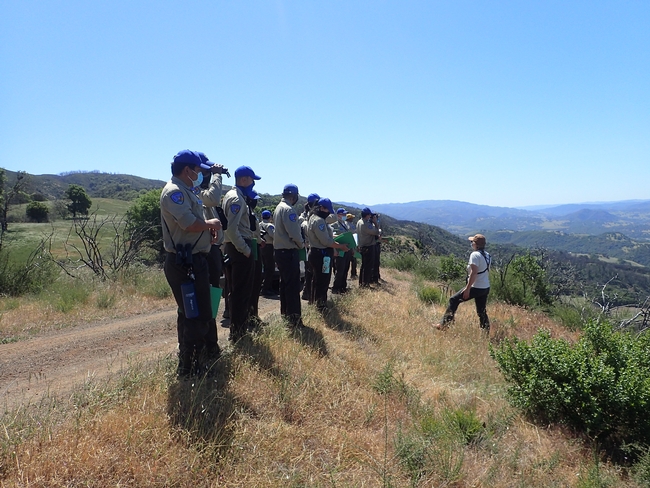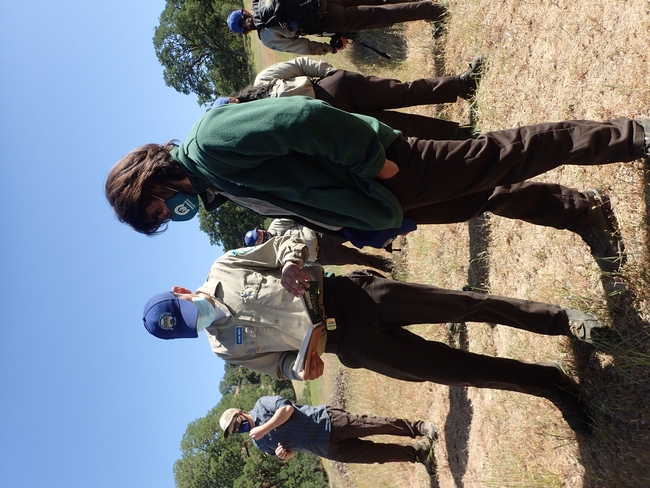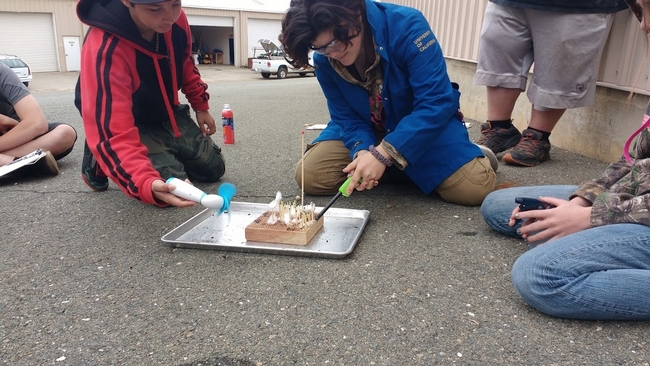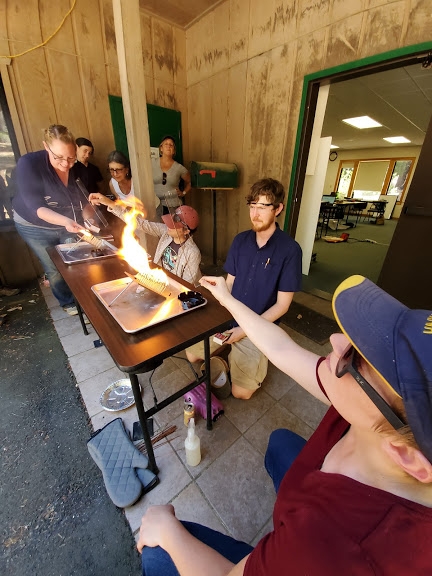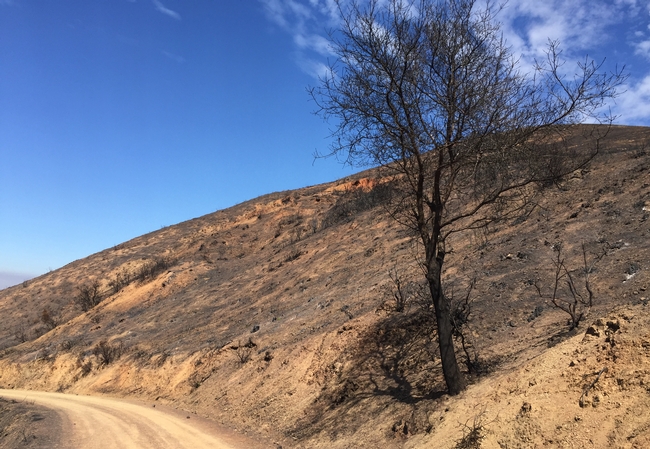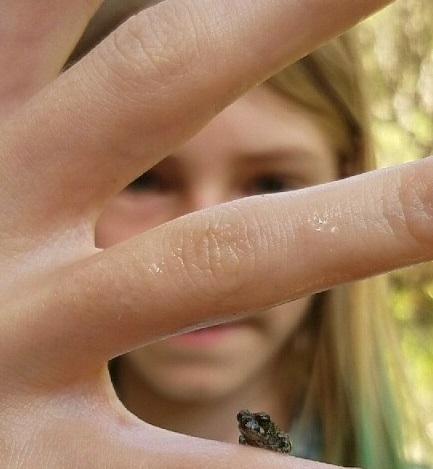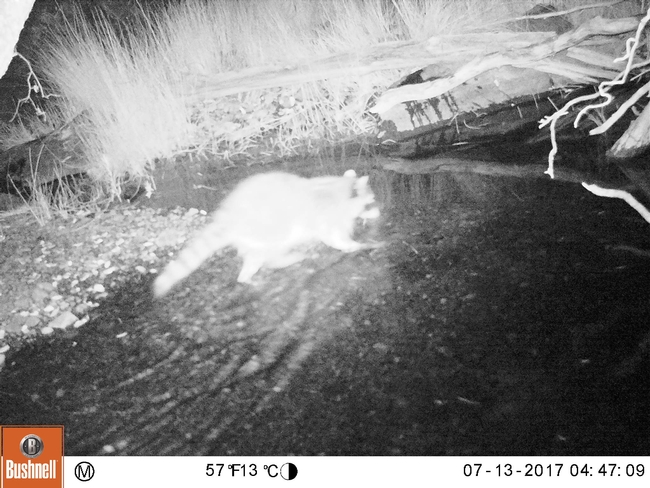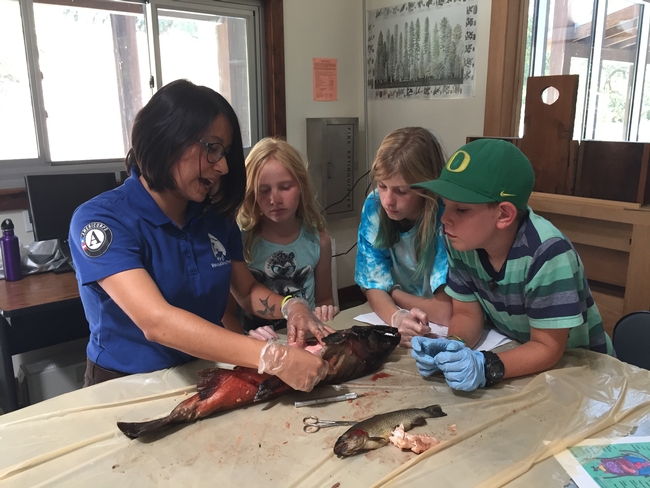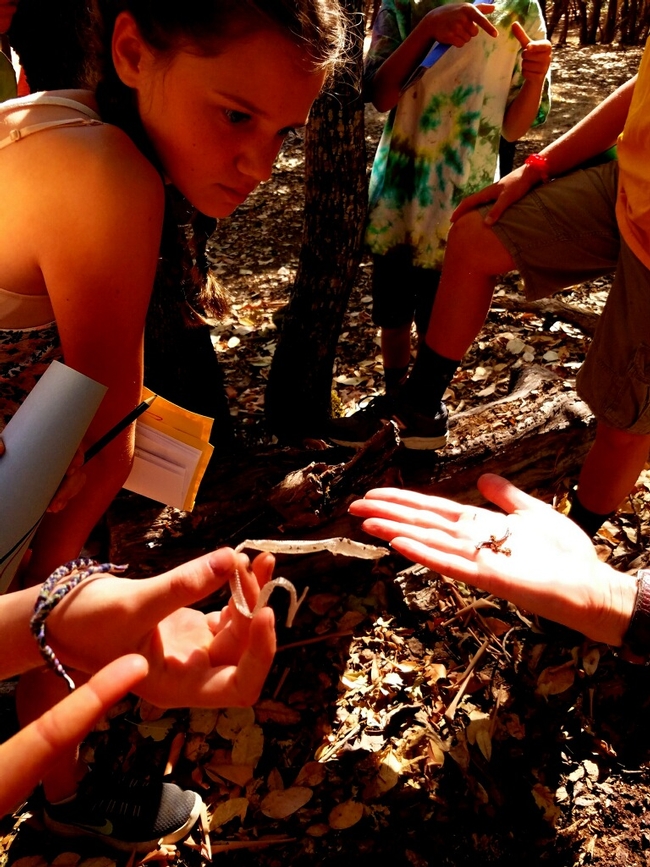Posts Tagged: Hopland Research
New wave of California Naturalists emerge from course at Hopland REC
Thirty-eight young, budding naturalists sit in a meadow while journaling and sketching their observations of the wildflowers and birds around them. They have come from various educational backgrounds to gather at the University of California Agriculture and Natural Resources' Hopland Research and Extension Center (REC) to learn about local natural ecosystems through a California Naturalist course.
Although they vary in expertise, these students share a common motivation: immerse themselves in the natural world and eventually teach others about its importance.
“The class really changed the way I view the world around me,” said Will Zuniga, a recent class participant at Hopland REC. “Now that I've taken it, I don't just see plants around me – I see stories. I understand more about the relationship that all of nature's moving parts have with each other. The class has given me more drive to learn about the world around me and to teach others as well.”
Under the UC ANR umbrella, the California Naturalist Program certifies participants through an immersive 40+ hour class delivered by one of its partner organizations, in this case, the California Conservation Corps (CCC). Aged 18 to 25 (and U.S. military veterans up to age 29) and from diverse educational backgrounds across the state, these California Naturalist students worked hard to fulfill the mission of the CCC – to protect and enhance California's natural resources and communities through education and service.
The California Naturalist Program promotes environmental literacy and stewardship through discovery and action. The program is designed to introduce Californians to the wonders of our unique ecology, engage the public in the study and stewardship of California's natural communities, and increase community and ecosystem resilience. Many other states have similar naturalist programs, but this is the first statewide program in California.
“California Naturalist training allows people of different backgrounds to come together to set what is the standard for how we talk about the sky, the ground below us, and the water that's flowing around us,” reflected Jacob Croasdale, a former class participant. “[They teach us] how to engage respectfully in a way that allows us to both receive and give back to nature.”
Although students graduate with broad knowledge of California's natural wonders, prior knowledge of the course's subject matter is unnecessary. “At first, I thought…I don't belong here. I'm just this artist - what do I have to offer?” shared Monique Wales, another former class participant. “There were Master Gardeners, geologists, biologists and people with crazy amounts of knowledge. But we all came together with such enthusiasm, and we wanted to learn from each other. It was such a fun group.”
“People who are thinking about the California Naturalist program but aren't sure that they know enough to step into something where the language is maybe more technical than they're familiar with should not be intimidated,” added Pete Devine, resident naturalist at Yosemite Conservancy. “A lot of participants are beginners and just generally interested folks. These people belong in the California Naturalist Program.”
A quick peek at the syllabus reveals many themes, field trips and interactions with local experts that culminate in the well-rounded knowledge necessary to help preserve our unique ecosystems. California has an incredibly diverse range of wildlife, habitats, rivers, lakes and coastal resources – wild and urban alike – and ecosystem and community resilience are essential.
After the course is completed, California Naturalists perform service through education and interpretation, stewardship, participatory science, environmental program support, community resilience and environmental justice. To date, certified California Naturalists, together with Climate Stewards (another component of the program), have volunteered more than 250,000 hours, worth over $7 million, in 52 of 58 counties in California.
The relationship between CCC and California Naturalist was piloted at the Hopland REC over the last two years and is now being rolled out across the state with support from the Prop 64 Youth Community Access fund. Overall, the project aims to offer three California Naturalist instructor trainings for 48 youth leaders, 24 California Naturalist certification courses for 480 Corps members, visits to or engagement with over 40 unique cultural and natural resources around the state each year, and 3,840 hours of service-learning outreach through youth-led video capstone projects promoting natural and cultural resources.
Overall (and most importantly), the California Naturalist Program allows corps members to have a solid connection to the “why” of their hard work.
Perhaps if we can all connect a bit more with nature in our backyard, we too will see the stories hidden in the plants, water, animals and land.
To prepare Californians for wildfire in oak woodlands, UC ANR offers teachers training
California's most destructive wildfire year on record was 2018, with devastating fires occurring in Northern California oak woodlands. From 2015 to 2017, six of California's 20 most deadly and destructive fires in history occurred in these areas. The communities living in oak woodlands, which had been mostly spared from previous wildfires, were largely unprepared.
To prepare Californians to live with wildfire, Kate Wilkin, former UC Cooperative Extension forestry/fire science and natural resources advisor, and UC Sierra Foothill Research and Extension Center and Hopland Research and Extension Center community educators Alexandra Stefancich and Hannah Bird received a $100,000 Environmental Protection Agency Environmental Education grant.
In addition to delivering community workshops, the educators will offer online training for teachers this summer. The curriculum will be introduced by webinar on Tuesday, July 14, from 11 a.m. to 11:30 a.m. (PDT). Register online for this free webinar at https://bit.ly/firecurriculum.
“The goal of this project is to educate youth and adults about their natural ecosystems and how to reduce the risk of catastrophic wildfire,” Stefancich said.
Even before the current COVID-19 pandemic constrained activities, challenges arose: the federal government shutdown delayed the grant; a wildfire burned approximately two-thirds of the Hopland REC; Wilkin moved on from UCCE and Rebecca Ozeran, UCCE livestock and natural resources advisor, took over leading the wildfire education project.
Training kids, adults and communities
The team is educating children, adults and communities. Their three-pronged approach includes youth education for 500 middle school students and training for teachers; adult education through advanced training for California Naturalists; and community education by partnering with Fire Safe Councils in Butte, Mendocino and Yuba counties.
“One of the most exciting aspects of this grant has been the youth fire education component,” Bird said. “The grant has funded an adaptation of theUS Forest Service's FireWorks Curriculum – first modeled for Rocky Mountains forests – to the California oak woodland ecosystem. This hands-on, place-based science curriculum aims to provide students an in-depth understanding of fire science. In working on this curriculum, the team wants to highlight the importance of not only oak woodland fire science, but the cultural history associated with fire on these landscapes.”
The grant allowed the team to work with local representatives from the Hopland Band of Pomo Indians, Kashia Band of Pomo Indians, United Auburn Indian Community and the Nevada City Rancheria to develop lessons shaped by the cultural value of fire as a tool and the long relationship between people and fire in California.
While developing the lessons, the team realized the importance of trauma-informed educational practices.
“Just five years ago, we often talked about wildfire theoretically, but now every student I speak with has their own experience to share,” Bird said. “It is important to give time in the lessons for the trauma experienced by our youth, and to educate them and encourage a sense of agency. These lessons focus on the positive! We don't spend time on things that we cannot change. We learn crucial concepts of fire science and build on them to make our schools, families and communities more fire prepared.”
Feelings about fire
The team piloted the new curriculum with more than 150 middle school students in Redwood Valley and Ukiah, just before schools closed due to the COVID-19 pandemic.
“Trialing the curriculum with students was really valuable,” Bird said. “These students have seen their communities affected by wildfire and it brings up many emotions for them.”
Students were asked to share their thoughts around fire at the beginning of the lessons and again at the end of the lesson series. Feelings of fear were replaced with feeling prepared and confident.
Before the lessons, students' comments about fire included, “Scary because I live in the mountains and my house is there, it could burn down.”
After the lessons, their comments included, “I felt positive about this, I feel that I know what to do, I think everyone should know how to prepare for fire.”
Pomolita Middle School students made an action plan for their school to help improve school fire preparedness. Students had hoped to present their plans to school administrators, but school closures due to the coronavirus crisis have delayed the presentation.
“Most of what we found at Pomolita school was really positive – the students do have a few suggestions that they hoped to share with the school administration,” Bird said. “Students also made an emergency contact plan and planned what they would like to have in a go bag for themselves and for their pets.”
Community educator Stefancich added, “This curriculum, aimed at middle school students, is ideal for any educator hoping to provide their students with more insight about the role fire plays in the ecosystem and how they can prepare for its eventuality. Each lesson is set up for the lay educator to be able to teach, so even without advanced fire knowledge it will be easy to use.”
The team continues to adapt the FireWorks curriculum for oak woodlands and expects it to be available at the FireWorks site https://www.frames.gov/fireworks/curriculum/overview by the fall.
Bee-ing All You Can Be and See and Do
What a weekend for bee and gardening enthusiasts! It's a shame we all can't clone ourselves and be in two places at the same time! The 40th annual...
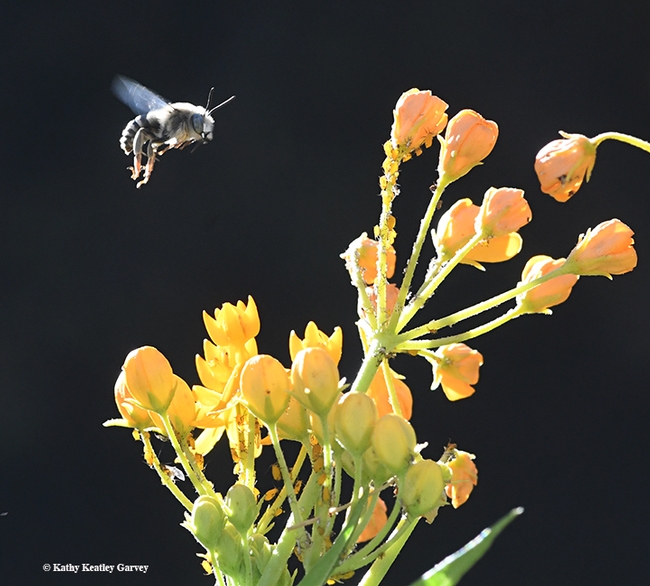
A native bee, Anthophora urbana, buzzes over a tropical milkweed. (Photo by Kathy Keatley Garvey)
What's That Bee? How to Identify and Attract Native Bees to Your Garden
Have you ever seen a bee buzzing around your garden and wondered: "What's that bee?" Or have you ever seen a bee nectaring in a community garden and...
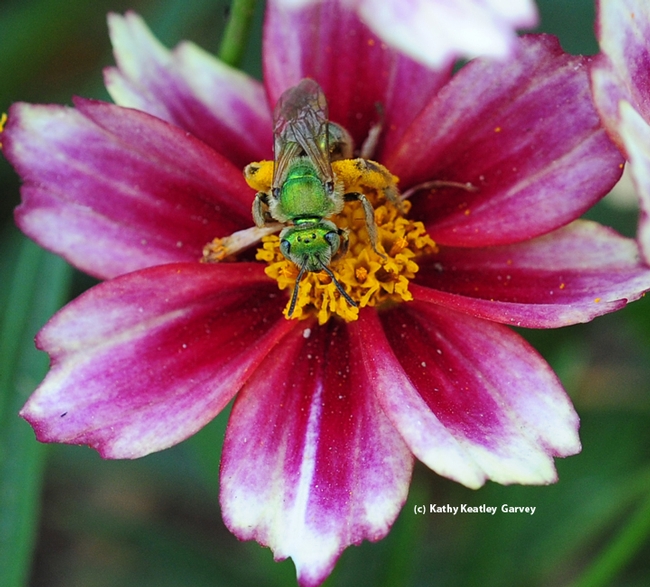
A female ultra green sweat bee, Agapostemon texanus, on Coreopsis tinctora 'Mahogany.' (Photo by Kathy Keatley Garvey)
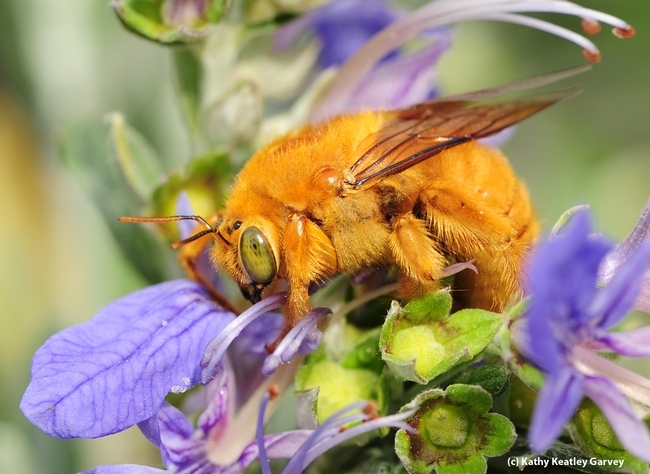
A male Valley carpenter bee (Xylocopa varipuncta) "the teddy bear bee" on germander. (Photo by Kathy Keatley Garvey)
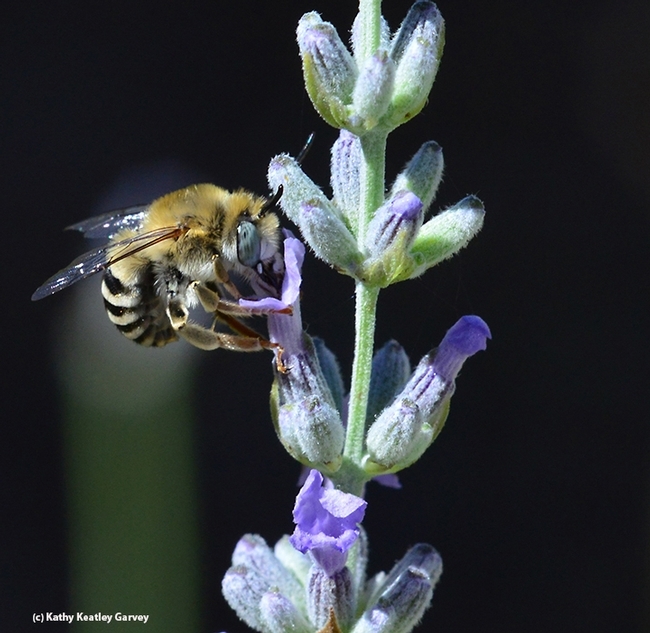
A digger bee, a male Anthophora urbana, on lavender. (Photo by Kathy Keatley Garvey)
Caging kids! The next generation of wildlife biologists
As 10-year-old Dominic Vargas crouched on the ground, in a cage not much larger than himself, trying to forage for tasty treats (candy) on the woodland floor...CRASH! The cage door came falling down and he realized that he had inadvertently tripped a tiny fishing line in his efforts to reach that candy - he was now trapped. Dominic seemed to accept his fate with good humor, shrugging, smiling and getting to work on that candy. Wildlife biologist, Jessie Roughgarden, commented that Dominic will now be collared, tagged and measured before returning him to the wild ... or in this case his parents.
This seemingly terrifying experience is in fact all part of the new "Sustainable You - 4-H Summer Camp" held at the UC Hopland Research and Extension Center. Sustainable You is a five-day camp allowing students to experience science and nature while learning about ways in which to conserve the land, water, air and energy.
View Dominic's experience in this 44-second video:
The camp is conducted at three of the UC Agriculture and Natural Resources' Research and Extension Centers across the state and each center tweaks the curriculum to suit their landscape and the kinds of research conducted at their sites. At Hopland this means getting the chance to meet with wildlife biologists from the UC Berkeley "Brashares Lab," led by professor Justin Brashares. It's an amazing opportunity for these kids to meet and ask questions of scientists conducting experiments in the countryside that surrounds them. Dominic may not be collared, but more than 10 deer on the property went through the same experience last week (minus the candy) as they were carefully captured by researchers and fitted with collars to better understand their movements and population across the 5,358-acre center.
The young team of scientists enjoying summer camp were also working to understand what wildlife shares the landscape with them by setting wildlife cameras daily and improving their positioning and locations each day. Advice from Brashares and Jessie Roughgarden helped the students improve their chance of catching footage of raccoons, foxes and maybe even a mountain lion. Day one produced fox video footage and shots of raccoons feeling around in the last pools of creek water to catch some of the tiny young frogs currently in residence.
Hear what Ahmae saw on her wildlife camera in the 59-second video below:
Exposure for these kids not only to hands-on activities exploring sustainability, but also to wildlife biologists, young researchers and professors working on today's wildlife and land management challenges, gives them an open door to explore their own future careers and interests.
As 9-year-old Ahmae Munday so sweetly put it, when asked what her favorite part of the Sustainable You Summer Camp was, "Everything! Especially the cameras."
The UC ANR network of Research and Extension Centers provide the perfect location to offer exposure to youth and communities to better understand and interact with the science going on in their own back yards and to inspire the next generation of researchers - as camp attendee and scholarship recipient Kaiden Stalnaker described in his scholarship application, "When I grow up I dream of a career in science and your camp would be a boost in the right direction."
Thanks to the researchers, camp counselors and students who have allowed the Sustainable You summer camp to inspire young people like Kaiden.


